Category: Idaho Military Divison
Idaho Army National Guard Soldiers prepare for deployment
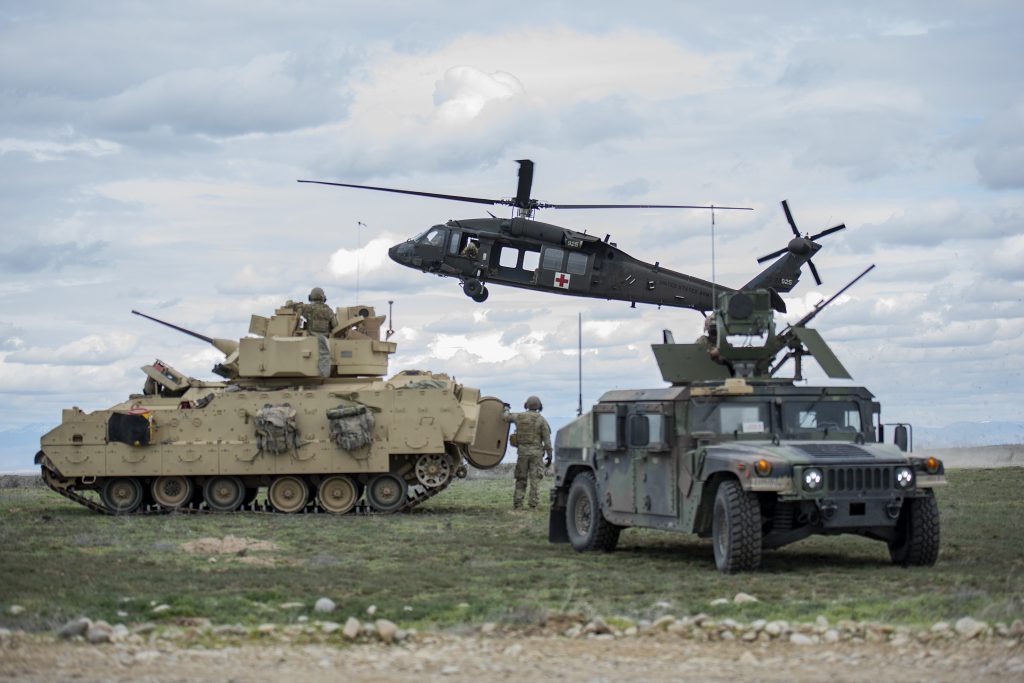
Maj. Robert Taylor/Idaho Military Division Public Affairs
The 2nd of the 116th Combined Arms Battalion conducted an extended drill period March 24 – April 1 at the Orchard Combat Training Center to build team proficiency prior to deploying in support of Operation Spartan Shield later this year.
“The battalion did a phenomenal job coming together as a team,” said Maj. Sam McDowell, 2-116th CAB commander.
M1A2 Abrams and M2A3 Bradley Fighting Vehicle crews conducted Table VI crew qualification tables and will build off their crew-level proficiencies to conduct platoon qualifications at annual training in May prior to mobilization and conducting a combined arms live-fire exercise at Fort Bliss, Texas.
The unit took advantage of several of the OCTC’s 23 training ranges to conduct individual weapon qualifications, crew-served weapon qualifications, a staff exercise, sniper training, Javelin firing and mortar training to Table III.
The battalion also teamed up with the Idaho Army National Guard’s 1st of the 183rd Assault Helicopter Battalion to conduct medevac and combat search and rescue training as well as air insertion missions on a simulated village located within the OCTC.
More than 700 116th Cavalry Brigade Combat Team Soldiers, comprising a task force led by the 2-116th CAB, will deploy to Southwest Asia for approximately 12 months in support of OSS later this year. OSS is a joint mission under the United States Central Command and is part of Operation Enduring Freedom.
The task force will relieve Task Force Griz, which is currently performing the same mission. Task Force Griz is led by the 116th CBCT’s 1st of the 163rd CAB and consists of Soldiers from the Idaho, Montana, Nevada and Oregon National Guards as well as augmentees from the Florida National Guard. More than 20 percent of the current task force is made up of Idaho Army National Guard Soldiers.
“The Soldiers of the 116th CBCT are training hard and will be prepared for this mission when they deploy,” said Lt. Col. Eric Orcutt, 116th CBCT commander.
The 116th Cavalry Brigade Combat Team previously deployed in support of the Global War on Terror in 2004 and 2010 to Iraq. Idaho National Guard personnel have been supporting the state of Idaho throughout the COVID-19 pandemic since 2020 and assisted the Idaho Department of Lands battle wildfires across the state last summer. Additionally, more than 400 Idaho Air National Guardsmen deployed to Southwest Asia in the summer of 2020.
Leveling up: Female Soldiers, Airmen serve in leadership positions across the Idaho National Guard
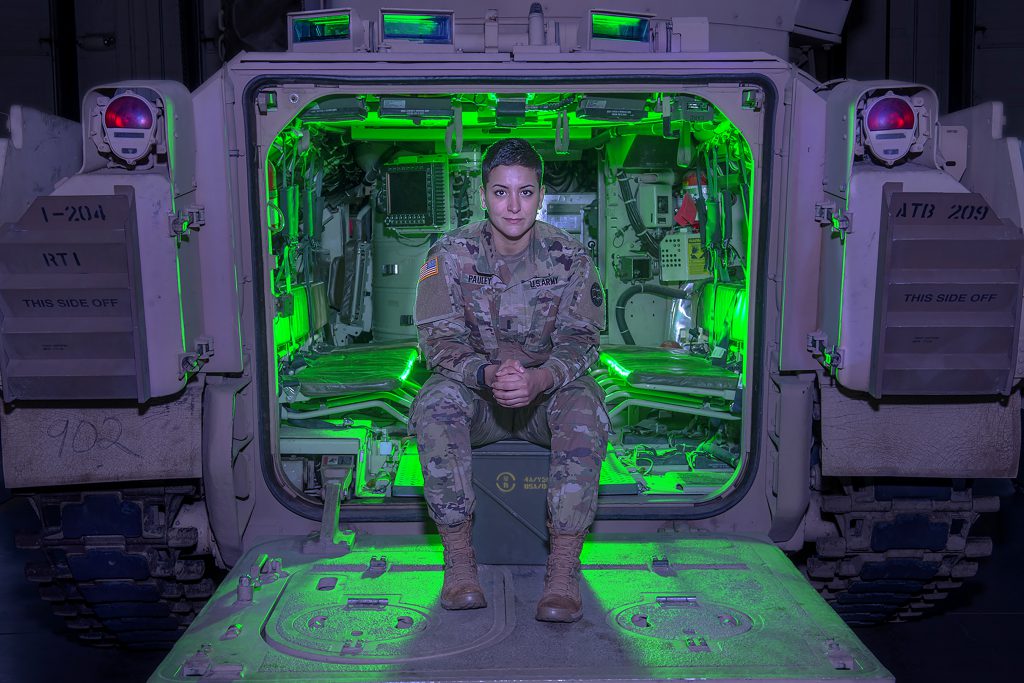
Maj. Robert Taylor/Idaho Military Division Public Affairs
Betty Corn became the first female to serve in the Idaho Air National Guard when she joined as a nurse in 1959. Female members wouldn’t enlist into the National Guard until 1968.
Since then, female citizen-Soldiers and Airmen have continued to blaze their own paths in the Idaho National Guard, even before the Army integrated females into combat-arms in 2015. Over the past decade alone, Idaho National Guardsmen have transitioned into career fields that were not previously opened to them or reached new heights in their profession while continuing to ensure the organization remains “Always Ready, Always There” to respond to emergencies at home or in defense of our national interest throughout the world.
In 2012, then Cpt. Nicole Smith, now Lt. Col. Nicole Washington, led more than a 100 Company A, 1-168th General Support Aviation Battalion Soldiers to Afghanistan for a year-long deployment, becoming the first female officer to lead an Idaho National Guard unit to combat as its senior officer.
In 2013, Chief Master Sgt. Tammy S. Ladley became the first female to serve as the 124th Fighter Wing’s senior enlisted member. The next year, Col. Sherrie McCandless became the first female to command the wing. McCandless now serves as the commanding general of the D.C. National Guard.
Also in 2014, Maj. Kimberly Tschepen became the state’s first female Soldier to command a battalion when she took command of the 145th Brigade Support Battalion and Command Sgt. Maj. Linda Burkhart became the state’s first female command sergeant major in 2015.
In 2015, Idaho Guardsman 1st Sgt. Erin Smith became the nation’s first female enlisted Soldier to graduate from M1 Armor Crewman School. Following her, Staff Sgt. Kylene Huerta completed the same course and became the first female Soldier to be assigned to the 116th Cavalry Brigade Combat Team as a tank crew member. In 2017, Sgt. 1st Class Melanie Galletti graduated from the U.S. Army’s Infantryman Course as the Idaho National Guard’s first qualified female enlisted infantry Soldier.
In 2017, Col. Lora Rainey was appointed as the state’s first female staff judge advocate.
In 2019, 2nd Lt. Brooke Berard and 2nd Lt. Lauren Bolt graduated from the U.S. Army’s Armor Basic Officer Leaders Course as the state’s first two female armor officers and 2nd Lt. Jessica Pauley became the state’s first female infantry officer.
Today, female Soldiers and Airmen proudly serve in leadership positions at every level of the Idaho National Guard, from the team level in the Army Guard to the group level in the Air Guard. In honor of women’s history month, we celebrate not only their accomplishments, but the fact that many of them are still writing their own history within our organization.
Female Soldiers and Airmen are trusted to lead their fellow Guardsmen. Soldiers like Sgt. Kaylee Bloxham, a combat engineer in charge of a Bradley Fighting Vehicle and its crew; and Airman like Chef Master Sgt. Kelly Bongiovi, who now serves as the senior enlisted member of the Idaho Air National Guard after she replaced Ladley as the 124th Fighter Wing’s command chief master sergeant.
On the officer side, 2nd Lt. Jessica Pauley, will lead an infantry platoon of infantry on a deployment later this year and Col. Elizabeth Sumner, the highest-ranking female in the Idaho National Guard, leads more than 340 Airmen as the 124th Mission Support Group commander.
Sgt. Kaylee Bloxham
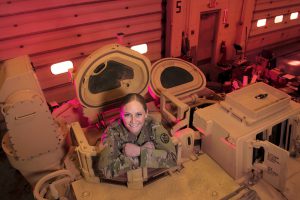 Sgt. Kaylee Bloxham didn’t set out to be the Idaho Army National Guard’s first female 12B combat engineer. It’s a feat she didn’t realize she had accomplished until after she graduated from the required reclassification course.
Sgt. Kaylee Bloxham didn’t set out to be the Idaho Army National Guard’s first female 12B combat engineer. It’s a feat she didn’t realize she had accomplished until after she graduated from the required reclassification course.
She was only looking to serve her country and follow in her older sister’s footsteps when she enlisted into the Idaho Army National Guard in 2006 as a military police Soldier. She reclassed after the 116th Brigade Special Troops Battalion transitioned to the 116th Brigade Engineer Battalion in 2016 and the unit eliminated its MP platoon.
Bloxham chose to become a combat engineer after observing engineers train on C4 demolition during annual training. However, she’s been assigned to a Bradley Fighting Vehicle for the past six years and has yet to complete demolition training herself since reclassing.
“I didn’t like the Bradley at first,” she said. “I didn’t know how it functioned, but now that I’ve been on it for a while and know how it functions, I really like it.”
Bloxham is a vehicle commander in A Company, 116th Brigade Engineer Battalion.
“Not only am I responsible for myself, I’m responsible for two others,” she said.
As a vehicle commander, she is also responsible for a 30-ton armored vehicle equipped with three weapon systems and its gunner and driver. She’s responsible for helping the driver maintain situational awareness in a vehicle with large blind spots and identifying and confirming enemy targets before giving the gunner the command of execution to fire.
“It’s fun,” she said.
She said she loves being able to lead and train her crew as a part-time member of the Idaho National Guard. When she’s not training, she also works as a parts specialist for High Desert Bobcat in Twin Falls.
Staff Sgt. Antonia Lemos
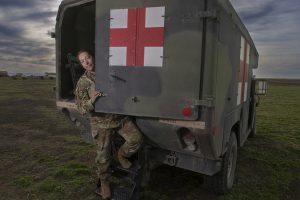 Staff Sgt. Antonia Lemos always knew she wanted to work in the medical profession when she was a kid. She never became a doctor because she didn’t finish college, but by enlisting into the Idaho Army National Guard, she was able to become a 68W combat medic and still have a career in the medical profession.
Staff Sgt. Antonia Lemos always knew she wanted to work in the medical profession when she was a kid. She never became a doctor because she didn’t finish college, but by enlisting into the Idaho Army National Guard, she was able to become a 68W combat medic and still have a career in the medical profession.
“I very much love being a medic,” she said. “As a medic, I am able to do a lot of the things I always wanted to do: help those who are hurt and see interesting wounds.”
Lemos enlisted into the Idaho Army National Guard in 2003. At the time, she was 20 and the single mother of two children. She said she was working fast food and retail and said she didn’t have a lot of direction or self-discipline to finish her education.
“As a single mom, it’s really hard,” she said. “Anything that would benefit my situation for my kids was a good thing and the National Guard looked like an avenue that would provide that, and in the end, it did.”
Lemos liked that she could join the military while raising her kids around her family. She was able to purchase a house by herself using a Veteran Affairs loan. She also found full-time employment as the Idaho Army National Guard’s drug testing coordinator, which interfered with plans to finish college, but she didn’t want to pass up the chance to be able to provide for her family.
Lemos is currently the emergency care sergeant for Headquarters and Headquarters Company, 2-116th Combined Arms Battalion. She was the first female Soldier organically assigned to the battalion when the Army started integrating females into combat-arms units in 2015.
She is a squad leader and assigned as the medic in charge of the battalion’s aid station. As a squad leader, she is in charge of eight Soldiers.
“At this point, I’ve been in long enough where I got to be that young Soldier and now, I’m mentoring young Soldiers,” she said. “Watching Soldiers grow is my favorite part of the job.”
Lemos said she tries to emulate good leadership for her Soldiers, which comes from good mentorship.
“Mentorship comes from above, below and side-to-side, it’s the full 360,” she said.
In addition to watching Soldiers grow, she enjoys being able to assist Soldiers who need additional resources in her role as the Idaho Army National Guard’s drug testing coordinator.
“My favorite part of being an NCO is finding someone who needs help and giving them the resources they need to hopefully be successful, not necessarily in the Guard, but in life,” Lemos said.
Lemos’s father, brother and uncle have also served National Guard.
Sgt. 1st Class Jessica Rice
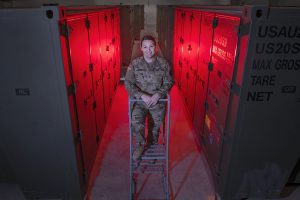 Sgt. 1st Class Jessica Rice has two jobs in the Idaho Army National Guard. During the week, she’s the accountable officer for the 116th Cavalry Brigade Combat Team’s Supply-Support Activity and during drill weekend, she’s a platoon sergeant for A Company, 145th Brigade Support Battalion.
Sgt. 1st Class Jessica Rice has two jobs in the Idaho Army National Guard. During the week, she’s the accountable officer for the 116th Cavalry Brigade Combat Team’s Supply-Support Activity and during drill weekend, she’s a platoon sergeant for A Company, 145th Brigade Support Battalion.
“I love it,” she said. “I’m responsible for training Soldiers. I get to teach them all the things I’ve learned in my 18 years and hopefully make them better than I am.”
As the accountable officer, she supervises seven Soldiers in the epicenter of logistics. The SSA provides a critical link between the brigade’s supply echelons and the national supply chain to ensure rapid fielding of repair parts, which drastically cuts down on the amount of time the brigade’s vehicles are down for maintenance issues.
Rice has supervised the SSA since it was established last year, a position typically held by a warrant officer. Only 11 National Guard states have an SSA.
Rice joined the Idaho Army National Guard after her first semester of college to help pay for her education. She ended up finding full-time employment in the organization before she could finish her degree. She’s been assigned to units in Boise and Burley as well as Lewiston and Post Falls multiple times.
“Throughout my time in the Guard, I’ve had six moves in 10 years,” she said. “Every time I’ve gone to a new unit, I’m instantly family. It doesn’t matter what I’m going through in my life, I have a dozen Soldiers who I could call at they’d be at my doorstep, and it wouldn’t matter why.”
At drill, Rice’s platoon of 22 Soldiers is responsible for distributing the brigade’s Class I (food, rations and water), V (Ammunition) and IX (repair parts) supplies.
As a leader, Rice said communication with her Soldiers is important.
“Make sure what you’re saying is what they are hearing,” she said.
1st Sgt. Lisa Carlin
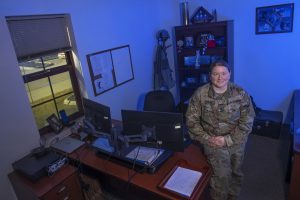 1st Sgt. Lisa Carlin remembers watching “Courage Under Fire” when she was 12 and knowing she wanted to join the military.
1st Sgt. Lisa Carlin remembers watching “Courage Under Fire” when she was 12 and knowing she wanted to join the military.
A few months after graduating high school, she enlisted into the Idaho Army National Guard in 2003 as a 15P aviation operations specialist. Unlike Meg Ryan’s character, she didn’t want to fly because she gets air sick. Aviation operation specialists support aviators from the ground and plan tactical missions.
Nearly two decades later, she is the first sergeant of 1-183rd Assault Helicopter Battalion’s Headquarters and Headquarters Company. As first sergeant, she is responsible for the health and welfare of more than 80 Soldiers.
“It’s all about taking care of Soldiers,” she said. “Regardless of what they have going on, they are the ones doing all the actual heavy lifting. If they aren’t getting taking care of, nothing else will get done.”
Carlin said she chose to join the Idaho Army National Guard over the U.S. Army because she wanted to remain close to home and pursue a college education.
“I already had friends and a support system here,” she said. “The idea of sticking around them seemed more appealing than uprooting every three years.”
Not only was Carlin able to remain close to her friends and family, but she has also made new friends over the years who feel like family.
“I like working with the same group of people throughout my career,” she said. “It builds a family mentality. You get to know them outside of work as well and become lifelong friends.”
The Idaho National Guard also gave Carlin the chance to serve with her actual family. Her sister is a security forces supervisor in the 124th Fighter Wing.
Carlin has been a member of the National Guard’s Active Guard/Reserve program since 2004. She’s served in multiple leadership positions in HHC before becoming its first sergeant. Currently, her readiness noncommissioned officer, Sgt. Kaitlyn Nicolosi, and training specialist, Spc. Jordyn Harris, are also female Soldiers entrusted with key company positions.
“Gender doesn’t play a role,” Carlin said. “It’s been my experience whoever does the job best gets the job.”
Chef Master Sgt. Kelly Bongiovi
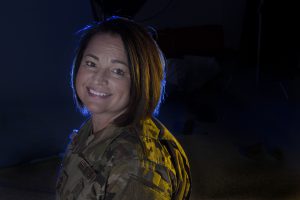 Chief Master Sgt. Kelly Bongiovi enlisted into the Idaho Air National Guard to provide a better life for her family. What she found was a career that has spanned more than three decades and led to her becoming the organization’s senior enlisted leader.
Chief Master Sgt. Kelly Bongiovi enlisted into the Idaho Air National Guard to provide a better life for her family. What she found was a career that has spanned more than three decades and led to her becoming the organization’s senior enlisted leader.
Bongiovi currently serves as the Idaho Air National Guard’s state command chief. By position, she is one of the Idaho National Guard’s most senior enlisted female members and she is the first female Airman to serve as the senior enlisted leader to the commander of the Idaho Air National Guard.
“I never planned on staying in the Air Guard this long,” she said. “I didn’t think they’d want met his long.”
Bongiovi enlisted in August 1991. She spent most of her career working nearly every logistic position in the 124th Fighter Wing before becoming the wing’s command chief in 2018. Over the years, the wing’s mission has changed from flying F-4s to flying A-10 Thunderbolt IIs and C-130s to only the A-10 mission. The logistics squadron’s name has also changed over that time, but Bongiovi’s work ethic has remained consistent.
“I was never in it to make a stripe,” she said. “I was always going to work my hardest and whatever came, came. I figured if I do good things, good things would happen. I just worked really hard and good things happened.”
Bongiovi decided to enlist shortly after tragically losing a child at birth. At the time, she was working in retail and the loss caused her to take a hard look at the life she would have been able to provide her child.
Several of her co-workers were members of the Idaho Air National Guard and told her about the many benefits they received as Guardsmen. Desert Storm was happening around the same time. Another co-worker’s husband deployed in support of the Gulf War but never made it home.
“I knew after I lost my kid, I needed to change my life,” she said. “I just had this passion of what I could do differently in the world to make a difference, not only for myself, but what I could do differently for my family. I also felt very passionate about what was going on in the world. I felt like I needed to join.”
Bongiovi said the biggest change she’s seen over the years is the seriousness of the National Guard’s mission and its increased operations tempo as the Guard became an operational reserve in the aftermath of 9/11. Bongiovi herself has deployed more than a half-dozen times in support of operations around the world.
Bongiovi has no question she was able to build a better life for her family since joining the Air Guard. She credits the support system she found through her fellow Guardsmen and the organization’s vast family resources as reasons why. In addition, she’s worked full time for the Idaho Air National Guard for the past 23 years and met her current husband through her military service.
Her husband, Hal, retired in 2020. He also served as the Idaho Air National Guard’s senior enlisted leader before advancing to the highest enlisted position in the Idaho National Guard as the state’s senior enlisted leader. Their oldest son is currently an A-10 Thunderbolt II crew chief in the 124th Fighter Wing and their youngest son is heavily involved in the organization’s family programs.
“You can pick yourself up when you have to and you can make yourself better,” she said, looking back on the path she’s taken since enlisting 31 years ago.
As the Idaho Air National Guard’s senior enlisted leader, she advises the commander of the Idaho Air National Guard, currently Brig. Gen. Tim Donnellan, on all enlisted matters. She said she doesn’t see the results of her work every single day like she could when she could physically watch A-10s take off and land on the flight line, but that the accomplishments feel much bigger when they do happen, however long they take.
She currently serves on the Air National Guard’s Enlisted Field Advisory Council. The committee works on proposed changes to policies and laws that impact Airmen across the force.
“When you see a policy go through that you’ve been working on for a year and it finally gets through the system and it’s going to make a change to thousands of Airmen, that’s a huge accomplishment,” she said. “It feels good knowing you’re going to help someone down the road.”
Bongiovi says she feels very privileged to serve in her current position but doesn’t dwell on being the first female Airmen to hold the position.
“I always try to help people,” she said. “I always tell Airmen to never miss an opportunity to learn no matter where they are in their careers. Look for something to work on and go work on it.”
In addition to looking for ways to improve, Bongiovi recommends having three people to confide in. She says have someone to tell the good, the bad and the ugly to, describing the good as the good things that happen; the bad things that happen; and someone who can help problem solve when necessary.
“The further you go up in the chain, the lonelier it gets,” she said. “You need people you can confide in when you start climbing the chain.”
Chief Warrant Officer 2 Kira Tank
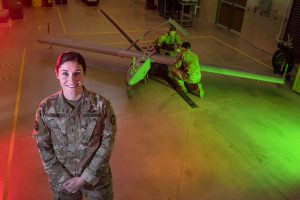 Chief Warrant Officer 2 Kira Tank is a dual-status federal technician, which means she has two jobs in the Idaho Army National Guard. During the week, she is the unmanned aerial systems supervisor for D Company, 116th Brigade Engineer Battalion. During drill weekend, she serves as the company’s operations officer and will become an instructor at the state’s Warrant Officer Candidate School next month.
Chief Warrant Officer 2 Kira Tank is a dual-status federal technician, which means she has two jobs in the Idaho Army National Guard. During the week, she is the unmanned aerial systems supervisor for D Company, 116th Brigade Engineer Battalion. During drill weekend, she serves as the company’s operations officer and will become an instructor at the state’s Warrant Officer Candidate School next month.
“I want to give back,” she said of her new position. “I’ve had a lot of excellent mentors and I think I can do that for other individuals and shape the future of the warrant officer cohort.”
Tank has served in the Idaho Army National Guard for the past 13 years. She began her career as an UAV operator before becoming a maintainer. She deployed with the 116th Cavalry Brigade Combat Team in 2010 in support of Operation New Dawn.
Upon returning from the deployment, she met then Chief Warrant Officer 3 George Tomlinson, who was assigned as the UAS platoon leader. She said she didn’t know much about warrant officers then, but Tomlinson mentored her and Jacob Stavenau and developed them professionally, which led to both Soldiers becoming warrant officers. Tomlinson now serves as the state command chief warrant officer.
As an enlisted member, Tank flew more than 350 UAV missions and reached the rank of staff sergeant before becoming a warrant officer.
“I love being able to bridge the gap between officers and the NCO corps,” she said. “Warrant officers are a very trusted profession. We’re subject matter experts. Officers rotate positions often and they lean heavily on us. They have to be able to trust us to give them the best advice.”
Tank said she joined the Idaho Army National Guard because she wasn’t sure what she wanted to do with her life, but she felt like the military was something she’d be good at. She said she’s made it a career because she really enjoys the comradery she’s found.
As the UAS supervisor, she oversees a team of eight Soldiers and coordinates missions for the company’s Shadow.
“We just have really great hard-working people who are held to a higher standard than their rank,” she said. “They have a lot of the same training and qualifications pilots do.”
She’ll take the lessons she’s learned from the past 13 years to her new position and use them to develop future leaders.
“Being a leader and a mentor is super important to me,” Tank said. “I’ll be able to play a key part in a pivotal point in someone’s career and be someone they can reach back to if they have questions.”
2nd Lt. Elizabeth Horan
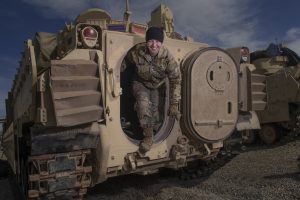 2nd Lt. Elizabeth Horan is a platoon leader for A Company, 116th Brigade Engineer Battalion. As a platoon leader, she leads three dozen 12B combat engineer Soldiers on the battlefield.
2nd Lt. Elizabeth Horan is a platoon leader for A Company, 116th Brigade Engineer Battalion. As a platoon leader, she leads three dozen 12B combat engineer Soldiers on the battlefield.
She joined the Idaho Army National Guard in 2017 as a 15D aircraft powertrain repairer and then earned her commission through BYU-Idaho’s ROTC program in 2020.
“I wanted to serve and to know that I contributed a little bit,” she said. “Plus, it’s fun.”
As a platoon leader, Horan said her job is making sure the platoon’s equipment is taken care of and that her Soldiers’ needs are met, in addition to making critical leadership decisions.
Combat engineers work to provide the maneuver commander with mobility, counter-mobility and survivability support, including detecting and clearing minefields and placing and detonating explosives. A Company uses Bradley Fighting Vehicles to provide engineer support to the 116th Cavalry Brigade Combat Team’s three combined arms battalions.
Horan said she enjoys getting to work with a Bradley crew and training with demolitions. As one of the Army’s junior officers, she relies on her platoon’s NCOs to help mentor her as she gains relevant experience in her career field.
“There’s a wealth of knowledge there,” she said. “A lot of those guys have been there for years and they are so willing to share what they know. It makes it fun to spend time with them on the Bradley and just do different things.”
As a platoon leader, she enjoys working with her Soldiers before she’ll take on additional administrative duties as she moves up in rank.
“Be willing to get dirty, get in and work hard next to your Soldiers,” she said. “Don’t try to excuse yourself from anything.”
1st Lt. Jessica Pauley
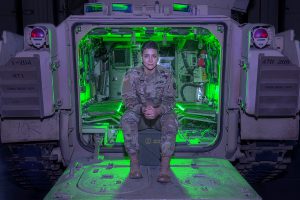 1st Lt. Jessica Pauley is thankful for the females who served before her.
1st Lt. Jessica Pauley is thankful for the females who served before her.
“They paved the way and without them, we wouldn’t be here,” she said.
As the first female infantry officer in the Idaho Army National Guard, Pauley helped paved the way for future female infantry Soldiers to serve in the 2-116th Combined Arms Battalion, but it’s a position she probably wouldn’t have sought out if she hadn’t been encouraged to do so by Sgt. 1st Class Melanie Galletti.
Galletti was the state’s first enlisted female Soldier to become 11B infantry qualified in April 2017. As part of the Army’s initiative to integrate females into combat arms positions, units were required to have a branch qualified female officer and a noncommissioned officer in place before new female recruits could be assigned to the unit.
Pauley knew that by becoming an infantry officer, along with Gelletti, she would pave the way for females to serve in the unit. Since then, several females have served in the state’s only infantry company, but Pauley is currently the only female assigned to the unit.
She’s a platoon leader for C Company, 2-116th Combined Arms Battalion. She oversees four Bradley Fighting Vehicle crews, including her own, and three squads of dismounted infantry Soldiers.
“It’s exactly the stuff people generally join the Army to do,” she said. “We shoot, we do squad and platoon exercises and there’s lots of hands-on training, including demolitions.”
Pauley said the hours are long, but the job is fun. She trains yearlong to be able to meet the physical demands of the job.
“It’s part of my job to be as physically fit as I can be,” she said. “If it comes down to it, Soldiers expect that from me and I expect that from them. Just like I’d expect any of my Soldiers to be able to pull a fully kitted Soldier out of a Bradley Fighting Vehicle while under fire. It’s dangerous if they can’t do it. It’s dangerous if I can’t do it as well.”
Pauley enlisted into the Idaho Army National Guard on her 23rd birthday in 2014. She served as a public affairs specialist before enrolling into the Boise State University ROTC program for her final two years of college. She said getting school paid for and getting paid to go to school seemed like a really good idea.
“It’s a good opportunity for everyone,” Pauley said. “It’s a relatively small commitment and you get the benefits of giving back to your country.”
Pauley has spent most of her career as a part-time Soldier and is looking forward to deploying with the 2-116th Combined Arms Battalion later this year so that she can spend additional time with her platoon.
“I’m excited for the opportunity to get some quality time with my platoon and train,” she said. “When we only see our Soldiers one weekend a month and a few weeks in the summer, there’s only a certain level of proficiency you can hit with that amount of time. We will have the chance to train every day and set some things in stone for Charlie Company that will last longer than our time in the unit.”
Pauley earned her commission in 2018 and attended the US Army’s Infantry Basic Officer Leaders Course in June 2019.
“The entire experience is a learning experience from the moment you swear in,” she said. “You’re faced with challenging situations, and you have to learn as much as you can from each one.”
As she’s grown throughout her time in the Army National Guard, she’s also thankful for those who have mentored her along the way.
“The commanders and first sergeants I’ve had the honor and privilege of serving with have taught me so much and they care so much about Soldiers,” she said. “It’s really inspirational.”
Capt. Haily Barley
 Capt. Haily Barley serves as the commander of Headquarters and Headquarters Company, 2-116th Combined Arms Battalion. She initially commissioned as a signal officer after graduating from the University of Idaho’s ROTC program but rebranched as an armor officer to be closer to the fight on the ground.
Capt. Haily Barley serves as the commander of Headquarters and Headquarters Company, 2-116th Combined Arms Battalion. She initially commissioned as a signal officer after graduating from the University of Idaho’s ROTC program but rebranched as an armor officer to be closer to the fight on the ground.
“I loved the signal community,” she said. “But at the end of the day, I’m just more comfortable and confident in this role, especially with my civilian career. I love it. You’re fighting the fight and have to make decisions more quickly.”
Barley served as a platoon leader and executive officer in the battalion before assuming command of its headquarters unit. As the commander, she is responsible for more than 180 Soldiers and ensures the battalion’s scouts, mortars, snipers, medics and staff are ready to execute their missions when called upon.
“The biggest part is just taking care of your Soldiers, wholeheartedly and leading from the front,” Barley said. “If they are not taken care of, then you don’t have a fight.”
The battalion is scheduled to deploy later this summer.
“I’m excited, but it’s bittersweet,” she said. “Now that I have kids, it’s a little rough, but it’s pretty much the reason you join.”
In addition to serving in the Idaho Army National Guard, Barley is a patrol deputy for the Canyon County Sheriff’s Office.
“Don’t be afraid to make decisions,” Barley said. “Someone might think you’re being bossy or bitchy, but you’re just trying to get your job done. Don’t be afraid to take the reins and learn or fail.”
Maj. Kristin Daigle
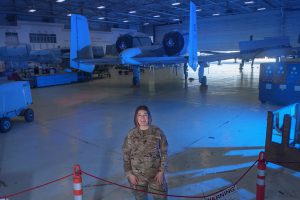 Maj. Kristin Daigle enlisted into the Idaho Air National Guard in 2004 to help pay for college.
Maj. Kristin Daigle enlisted into the Idaho Air National Guard in 2004 to help pay for college.
She attended college at Boise State University without having to take out any student loans and found full time employment within the 124th Fighter Wing shortly after graduation. With her degree, she was also able to commission as an intelligence officer.
“I always wanted to be an officer,” she said. “The timing seemed right.”
Daigle was hired to be an instructor for the wing’s Intelligence Formal Training Unit after spending seven years as an enlisted intelligence analyst. She also worked as the wing’s sexual assault response coordinator and as the executive officer for the Idaho Air National Guard.
Today, she’s the commander of the 124th Fighter Wing’s Maintenance Operations Flight, a position she sought for increased leadership responsibilities.
“Best decision I ever made,” she said. “I love being in maintenance!”
The flight is responsible for the long-range management of the wing’s A-10 Thunderbolt II aircraft and manages aircraft maintenance to meet operational requirements for the 190th Fighter Squadron.
“There are different challenges presented every day,” she said. “There’s always something breaking and you have to figure out how to fix it and still meet the wing’s flying schedule.”
The flight consists of five shops and more than 20 Airmen. Daigle has been in command of the flight since 2019.
“It’s given me an appreciation for everyone’s different perspectives that they bring to the job and I try to balance the mission requirements with making sure the people are taking care of,” she said.
Lt. Col. Christina Taylor
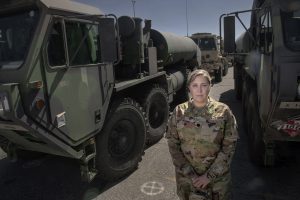 Lt. Col. Christina Taylor joined the University of Idaho Army ROTC program to help pay for college. She chose to commission into the Idaho Army National Guard after graduating so she could have a hand in deciding her future.
Lt. Col. Christina Taylor joined the University of Idaho Army ROTC program to help pay for college. She chose to commission into the Idaho Army National Guard after graduating so she could have a hand in deciding her future.
“I didn’t want the Army to choose for me,” she said. “I wanted to create my own path.”
By serving in the National Guard’s Simultaneous Membership Program, she was able to drill with an Idaho Army National Guard unit while still in college and identify a position for her to serve in after commissioning. Had she chosen to serve in the active Army, the Army would have selected her assignment and duty location.
Taylor drilled with C Company, 145th Brigade Support Battalion, 116th Cavalry Brigade Combat Team and remained with the unit after she commissioned in 2002. It began a path that has led to multiple command positions for Taylor since 2015.
In 2015, Taylor led the Mission Training Complex – Gowen Field. After a short break, she commanded C Company, 145th BSB for most of 2017. She then took command of the Idaho National Guard’s 101st Civil Support Team in February 2018 before transitioning out of that position to command the 145th Brigade Support Battalion last year.
As the 145th BSB commander, Taylor is the 116th Cavalry Brigade Combat Team’s senior logistician and is responsible for ensuring the unit’s maneuver commanders can maintain their operational reach for prolonged periods of time by maintaining logistical and sustainment support in the operational environment. The battalion consists of more than 400 Soldiers that comprise a distribution company, a field maintenance company and a medical support company in addition to forward support companies located throughout the state.
Taylor is also the brigade’s highest-ranking female Soldier, a fact she doesn’t pay much attention to.
“Never in my career has it ever been about me being a woman,” she said. “It’s always about being capable to assist the organization. The Guard’s provided a really great career path for me to be able to grow and learn as a leader. That’s why I chose to make it a career.”
Taylor earned her degree in elementary education and worked as a teacher prior to deploying with the 116th CBCT in 2005 in support of Operation Iraqi Freedom III. She started working fulltime for the Idaho National Guard shortly after returning home from deployment when she was hired as the medical operations officer for the 101st Civil Support Team.
“I like how we can directly give back,” she said. “You can show how one person can actually have an impact and give back to our fellow citizens, state and nation.”
Taylor describes leadership as an upside-down triangle, with leaders representing the bottom point, holding up and supporting Soldiers.
“We work to meet their needs,” she said. “With that mindset, we accomplish a lot more.”
Col. Elizabeth Sumner
 Col. Elizabeth Sumner is the highest-ranking female in the Idaho National Guard. She leads more than 340 Airmen as the 124th Mission Support Group commander.
Col. Elizabeth Sumner is the highest-ranking female in the Idaho National Guard. She leads more than 340 Airmen as the 124th Mission Support Group commander.
The 124th Mission Support Group consists of four squadrons and one flight and provides a wide range of support for the 124th Fighter Wing. The group includes facilities, communications, security forces, logistics, civil engineering, contracting and force support.
“People are my mission,” she said. “I focus on getting them the resources they need to be successful because they are the ones who accomplish the Air Force’s mission.”
Sumner began her career in the United States Air Force before transferring to the Idaho Air National Guard in 2008 to find a good balance between having a military career, a civilian career and a spouse who also served in the Air Force.
“I thought it was the perfect marriage of things I liked to do,” she said. “I drilled on the weekends and I worked for an engineer company in Boise during the week.”
Sumner served in the Alaska National Guard and the Florida National Guard as her husband received new assignments before transferring back to the Idaho Air National Guard again in 2014 when he retired.
“I always wanted to serve,” she said. “I like being part of something bigger than myself and I like the discipline that comes with serving in the military.”
Sumner started her military career as an intelligence officer and later became an instructor at the wing’s Intelligence Formal Training Unit. She realized that the same qualities that would make her a good instructor to her students would also make her a good leader to her Airmen: be humble, credible and approachable.
“I think what we do in the Guard is such an incredible balance to the active duty,” Sumner said. “It comes from vast different experiences everyone brings. As a leader, it’s important to realize that differences can be a huge strength to an organization and that we should invite those differences of opinion, perspectives and experiences so we can get to the best solutions.”
Idaho Army National Guard’s newest range fully certified
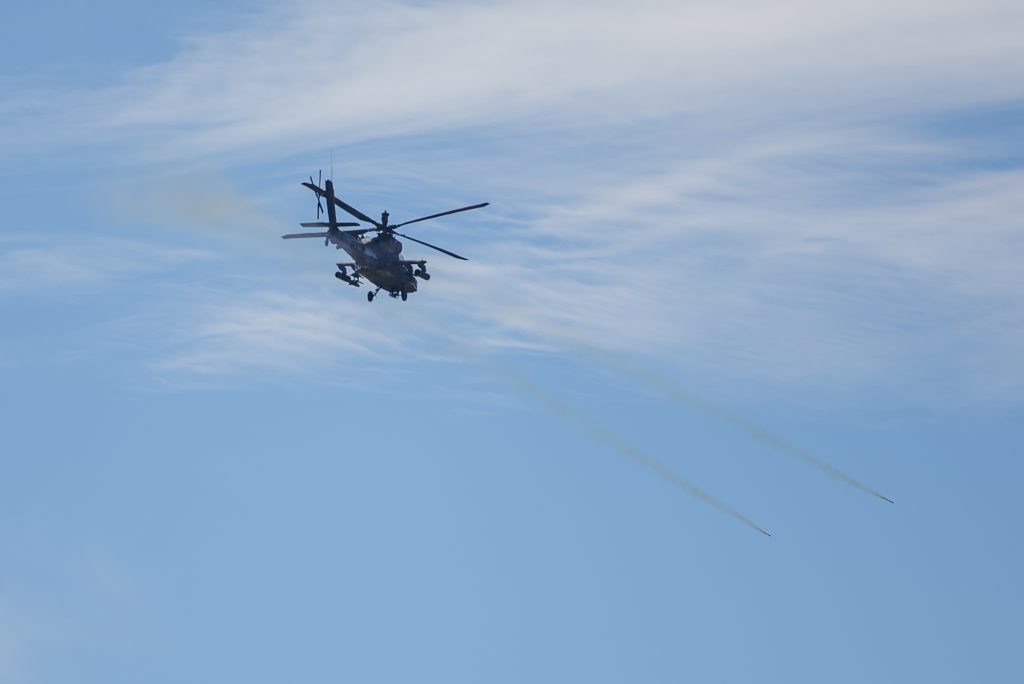
Washington’s Apaches, Soldiers assist Idaho in final testing for new range
By Master Sgt. Becky Vanshur/Idaho Military Division Public Affairs
The Idaho Army National Guard completed its Government Acceptance Test on its newest range, March 5-11, at the Orchard Combat Training Center. The Digital Air Ground Integration Range needed the aircraft portion of the GAT to become fully qualified. Previous components of the test were completed last spring with Abrams tanks, Bradley Fighting Vehicles and Strykers.
“It’s very exciting to complete the last element of certifying the OCTC’s DAGIR,” said Brig. Gen. Farin Schwartz, commander of the Idaho Army National Guard. “The exceptional capability of this valuable training resource is available to enhance combat readiness to crew members of all weapon systems, including pilots who train on this range.”
The U.S. Army’s 1st of the 229th Attack Reconnaissance Battalion pilots and crew members from Joint Base Lewis-McChord, Washington, conducted crew qualification using their AH- 64 Apache helicopters on the DAGIR throughout the week.
Construction on the DAGIR was completed last year, making it the only National Guard ran DAGIR range and only one of two such ranges across the U.S. Army. The range allows air and ground units to train together while receiving accurate and real-time feedback on their performance.
Although aviation units have used the range since its opening, last week was the first time range officers were able to schedule an aviation unit that met the correct requirements to conduct the GAT.
Special electronic equipment is placed on vehicles or aircraft to collect data. That data is sent back to the range tower and compiled into useful information for the after action review of each vehicle or aircraft that uses the range. The 1st of the 229th Attack Reconnaissance Battalion tested its Aerial Weapons Scoring System using 30 mm rounds of M789 High Explosive Dual Purpose ammunition and 2.75-inch Hydra-70 rockets.
Manned and unmanned aviation crews; armor, Stryker and infantry crews; and other sections and platoons can conduct combined arms live-fire exercises together on the range using 200 different targets that provide more than 400 possible training scenarios.
The DAGIR is the primary qualification range for AH-64 Apaches and an approved alternate range for tanks and Bradley Fighting Vehicles. The range can simulate multiple vehicles working together with air support, as well as unmanned aerial vehicles providing over watch.
A conex village on the range provides units the opportunity to train on dismounted operations and to incorporate Marines and Air Force joint terminal attack controllers on the ground into the training scenario.
“The DAGIR is a great asset to the OCTC and the units that train here,” said Capt. Jeff Dahl, OCTC Range Officer. “The range compiles information from the vehicle and crew during their gunnery and provides additional feedback to the units to better train crews and help build platform proficiency. Having the DAGIR added to the existing OCTC facilities is a huge benefit and we hope it continues to attract units to come train in Idaho.”
The Idaho National Guard’s OCTC is located 19 miles south of Boise. Its 143,000 acres and 23 training ranges provide vast terrain to facilitate world-class training to prepare brigade combat teams and other units for combat through a tough and realistic training environment.
Idaho National Guard trains together for joint combat rescue missions
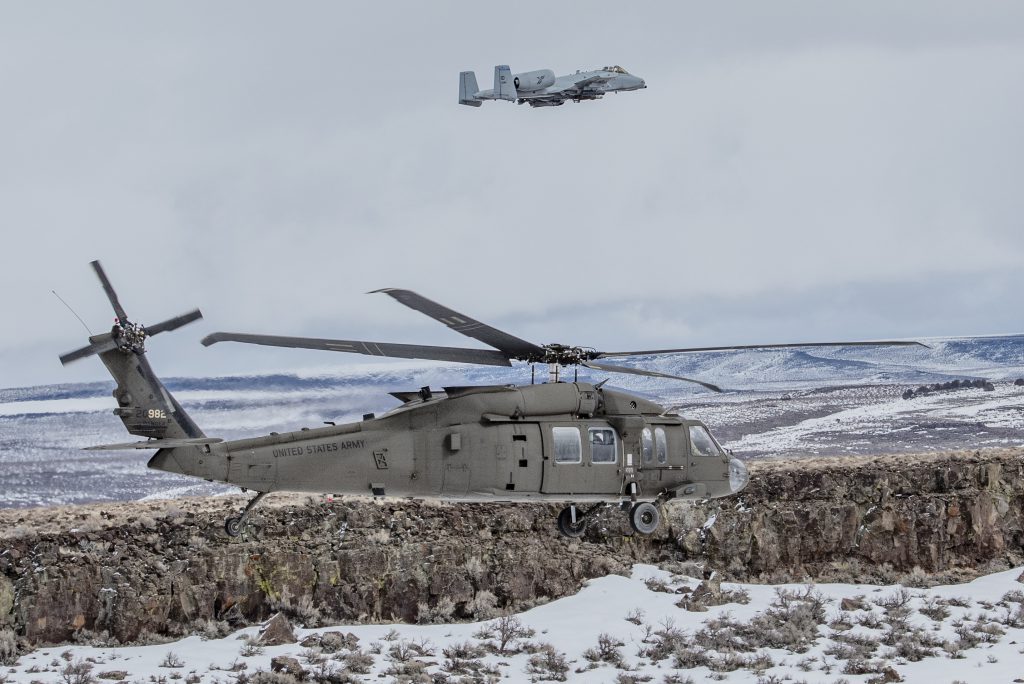
Master Sgt. Becky Vanshur/Idaho Military Division Public Affairs
Idaho Army National Guard and Idaho Air National Guard aviation units conducted combat search and rescue training together March 9 throughout Idaho’s Owyhee Mountains.
“Any opportunity to integrate the Army and Air missions in a joint training capacity is beneficial to both units,” said 1st Lt. Kate Smith, a mission planner for the Idaho Army National Guard’s Army Aviation Support Facility. “Because our missions can overlay in-country and in combat, anytime we have that ability to work together and integrate our systems, the training only helps our operations to be more seamless when it comes to the real-world missions.”
The training rescue missions involved 124th Fighter Wing A-10 Thunderbolt II pilots escorting Idaho Army National Guard Aviation Group’s UH-60 Black Hawk pilots along the safest route of a simulated combat zone and advising them of any possible enemy threats. The Idaho Air National Guard’s 266th Range Squadron provided simulated threats to pilots from both forces using its Joint Threat Emitter equipment.
Airframes such as the UH-60 Black Hawk require A-10 Thunderbolts or other fighter jets to escort them in CSAR missions during combat operations because Black Hawks are a transport aircraft designed to extract or recover personnel and do not have the capacity to carry heavy weapons.
After the A-10’s ensure the safety of the extraction point, the Black Hawks can approach the extraction site and utilize their hoist rescue equipment or land on the ground to recover personnel. The A-10s continue to provide air-to-ground support while circling the area. After the personnel have been recovered, the A-10s escort the helicopters until they are out of enemy contact.
“Having the Idaho Army National Guard assets readily available to allow realistic training scenarios for our fighter pilots is a huge benefit that we absolutely have to capitalize on when and where we can,” said Col. Chad Kornberg, 124th Fighter Wing commander. “The combination of airspace, threat simulation and air assets that we have in Idaho enable some of the most premier training opportunities in the nation.”
Because the Idaho National Guard’s aviation assets are co-located on Gowen Field, units are routinely able to conduct training together to increases its interoperability working with other services while conducting enhanced training that may not otherwise be available.
“Although the Idaho Army and Air National Guard have already been successfully working together for years, it is a strategic goal to amp up our joint training. We want to integrate with our assets as much as we possibly can going forward,” said Smith.
Guardsmen help with understaffing, serve locally
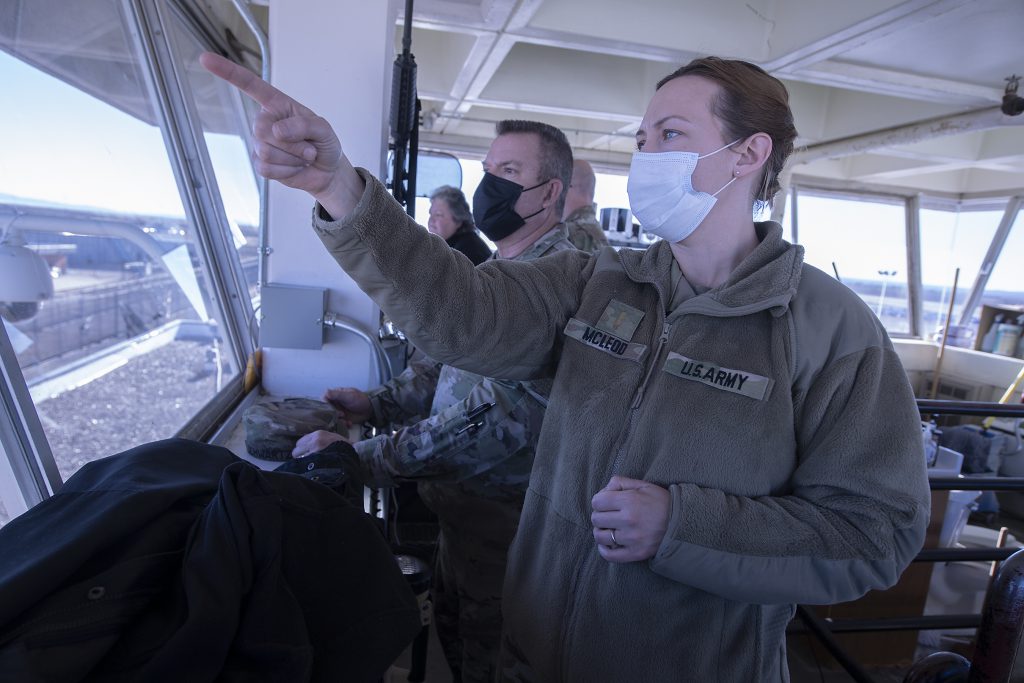
Maj. Robert Taylor/Idaho Military Division Public Affairs
Spc. Kyle Shuman grew up an Army brat and wanted to enlist into the Army himself. Five years ago, he enlisted into the Idaho Army National Guard as a 68W combat medic.
“I wanted to follow in my dad’s footsteps,” he said. “He used to say good things about the military. I thought that being in the National Guard would be a good way to serve in my community and still be in the military and have a civilian career.”
Shuman is one of approximately 75 Idaho National Guardsmen currently assisting the Idaho Department of Correction overcome staffing shortages due to the COVID-19 pandemic. Gov. Brad Little activated the Idaho National Guard for the fourth time Jan. 31, which also included support at multiple Primary Health Medical Group locations until Feb. 25.
Citizen-Soldiers and Airmen are performing non-security duties while the department is severely understaffed. He previously volunteered with the task force last year and deployed to Washington, D.C. in June 2020 to assist local civil authorities as part of an effort that included more than 5,000 National Guardsmen from 11 states and Washington D.C.
“I didn’t know what the mission would be,” he said. “I just volunteered to get new experiences and to get to do things I don’t get to do everyday and to meet people from other units.”
At the prison, Shuman said he assists with monitoring cameras in a control center and opens and closes doors as requested by correctional officers. Shuman said Guardsmen performing similar tasks throughout IDOC facilities helps free up correctional officers to perform security duties. The additional personnel allow residents to move around the facility as normal. Prior to the Idaho National Guard assistance, residents spent an increased amount of time in their cells throughout the day due to a lack of correctional officers.
“It makes me feel good to go out there and help the correctional officers with whatever they need help with,” said Sgt. 1st Class Vincent Mele, the non-commissioned officer in charge of the Idaho Guardsmen working at the state’s minimal security facility.
Mele is working at the facility’s front desk, where he helps sign visitors and staff in and out of the prison and answers the prison’s telephone.
“This mission provides a really good perspective on the world that maybe you didn’t have before hand,” he said. “We all get an idea of what the prison system might be like, and it’s definitely a little different in Idaho than I pictured.”
Guardsmen anticipate assisting IDOC until mid-March. Shuman, Mele and other Guardsmen will then return to their civilian jobs in their respective communities.
“We thank you for everything you’re doing for our staff and residents,” said Warden Timothy Richardson. “Before the Idaho National Guard arrived, at one point we were down to 48% staffing. We realize this is a unique and uncertain environment, but you’ve provided a solid cadre of troops and we couldn’t ask for a better group at such a critical time.”
Idaho deploys a small unit to the AFRICOM Area of Responsibility
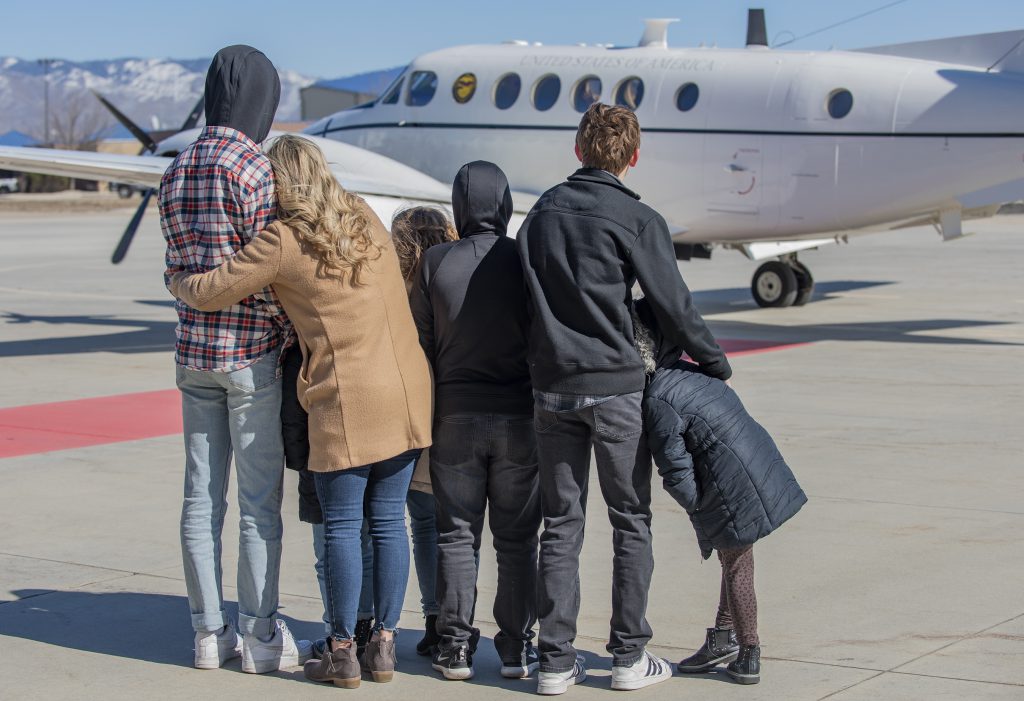
Master Sgt. Becky Vanshur/Idaho Military Division Public Affairs
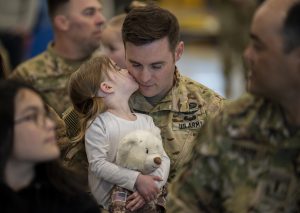 The Idaho Army National Guard Aviation Group deployed a small unit to the AFRICOM Area of Responsibility in support of Operation Enduring Freedom on Feb. 23, 2022. The unit will deploy for less than a year.
The Idaho Army National Guard Aviation Group deployed a small unit to the AFRICOM Area of Responsibility in support of Operation Enduring Freedom on Feb. 23, 2022. The unit will deploy for less than a year.
“The Idaho National Guard always answers the call when we are needed,” said Chief Warrant Officer 4 Spencer Widman, the unit’s commander. “The Africa mission is a noble example of this. I’m proud of the exemplary work the unit has accomplished when called upon in the past and I know their professionalism during this mission will fall in line with the Idaho National Guard’s high standards.”
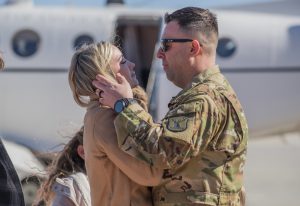 The small unit is based at Gowen Field and flies the C-12 Huron aircraft. This is a routine mission and the unit has supported several of these rotations in the past.
The small unit is based at Gowen Field and flies the C-12 Huron aircraft. This is a routine mission and the unit has supported several of these rotations in the past.
In 2010, the unit deployed to Afghanistan in support of Task Force Odin. They returned to Afghanistan in support of Task Force Caesar in 2013. In 2015, the unit deployed to Bogota, Columbia and to Kuwait in 2016 in support of Spartan Shield.
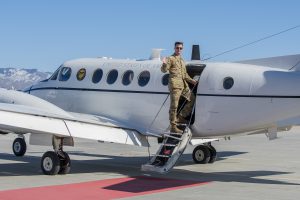 The C-12 Huron can readily accommodate cargo, passengers or both. It is also equipped to accept litter patients during medical evacuations missions. The first C-12 models entered service with the U.S. Army in 1974 and were used as a liaison and general personnel transport.
The C-12 Huron can readily accommodate cargo, passengers or both. It is also equipped to accept litter patients during medical evacuations missions. The first C-12 models entered service with the U.S. Army in 1974 and were used as a liaison and general personnel transport.
Daughter commissions into the Idaho Army National Guard as her father retires
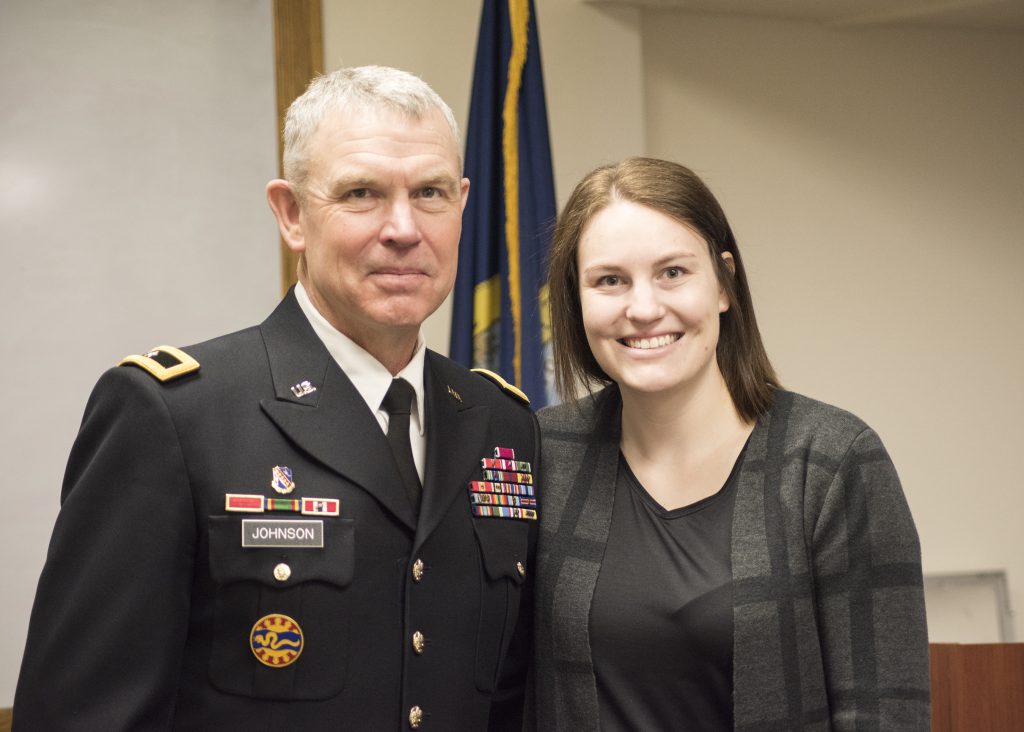
Maj. Robert Taylor/Idaho Military Division Public Affairs
2nd Lt. Marah Sharpe’s father has served in the Idaho Army National Guard for longer than she’s been alive. But despite commissioning into the organization Jan. 28, she will only have the opportunity to attend the same drill weekend with him once.
Her father, Brig. Gen. Russell Johnson, is set to retire in March after more than 41 years of service to the state and nation. Johnson, who currently serves as the Idaho National Guard’s director of the joint staff, first enlisted into the Idaho Army National Guard in November 1985. He served in the Marines from January 1981 to November 1985.
Sharpe direct commissioned as a 66H medical surgical nurse and will serve in the 116th Cavalry Brigade Combat Team, which Johnson commanded from February 2014 to March 2016.
“I don’t remember a part of my life that the Idaho Army National Guard wasn’t in,” Sharpe said. “My dad’s been in since I was born. The Guard has always been a part of my family and a part of my life growing up and I’m excited to be part of that organization myself.”
Sharpe said she previously considered joining the Idaho Army National Guard but the timing hadn’t been right. Now that she has completed her education and settled into her career as a nurse at Saint Alphonsus Regional Medical Center, she felt the timing was right.
Her ability to maintain her civilian career at Saint Alphonsus was important to her.
“I can stay in my civilian job that I really enjoy and be in the Guard at the same time,” she said. “It just seemed right.”
Sharpe said she became a nurse because she likes the flexibility the career offers, the science behind her job and the ability to help people. She is looking forward to practicing medicine in a uniform in addition to scrubs as she learns the demands of being a Soldier.
“I’m most excited to expand my knowledge as a nurse and as a person,” she said. “There’s a lot of learning opportunity for leadership as well as nursing. I’m excited to grow in both areas. I want to be a better nurse and be a better person.”
As a medical professional, Sharpe was able to earn a direct commission into the Idaho Army National Guard without having to complete basic training or a commissioning school. The Idaho Army National Guard accepts six to 10 such appointees each year, which include medical professionals, attorneys and chaplains.
“It’s always a proud moment when someone’s child goes in to the military,” Johnson said. “It shows a commitment to our state and nation with a level of enthusiasm and ambition that they share.”
“The Army and the National Guard are constantly changing,” said Johnson. “One thing that hasn’t changed is the importance of service to our country and state. Today’s Guard is in need of upcoming leaders and folks willing to step up and volunteer their time and efforts. It’s neat to see that level of commitment.”
Johnson administrated Sharpe’s commissioning oath Friday on Gowen Field.
“I’m very proud of her,” Johnson said.
Idaho National Guardsman develops wellness through Yoga
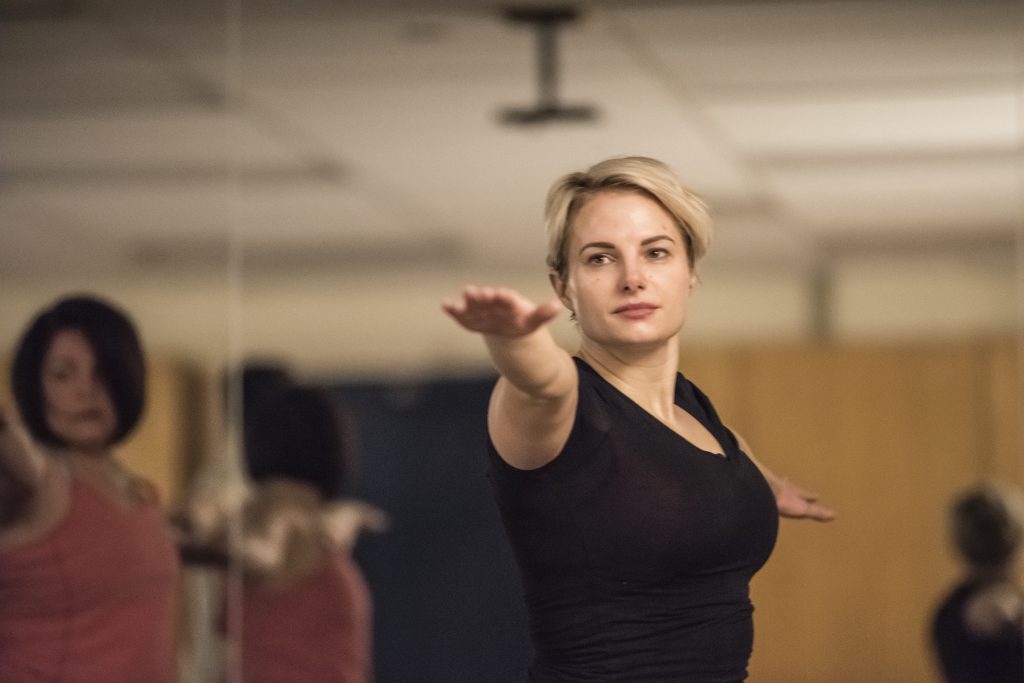
Crystal Farris/Idaho Military Division Public Affairs
After saying goodbye to her husband and kids, Master Sgt. Mary Ellen Reed heads to the gym early every morning for her daily workout. Working full-time for the Idaho Air National Guard and being a mother of two, Reed said it’s the only time in the day she has to herself to work on her physical and mental wellbeing.
“I go to bed excited to wake up the next morning and go to the gym,” said Reed. “It’s my favorite part of the day, beside maybe when I get home from work, but then the dog needs something from me or the kids are like “Mom, Mom,” and I’m on duty again, just in another capacity.”
One day a week she wakes up extra early on Thursdays to follow up her gym routine with a yoga session on Gowen Field where she works as a career manager for the 124th Fighter Wing.
The Idaho National Guard’s Service Member and Family Support program, with the help of two certified Yoga instructors who work for the organization, offer Warrior Yoga as one of its wellness opportunities for service members free of charge.
“We started offering the classes because yoga can help our service members develop a balance between mind, body and soul,” said Maj. Jennifer Pate, Idaho National Guard holistic health and fitness officer. “These are skills necessary to prevent harmful behaviors and to achieve true wellness.”
Although Reed had never practiced yoga, she is an avid weightlifter and has been training for body building competitions since 2018. She originally looked into practicing yoga to improve her mobility for competitive posing. Months after starting it, she realized its multifaceted benefits extended beyond just physical ones.
“While yoga has helped me improve my mobility tremendously, I feel it has become more of a mental benefit to me,” said Reed. “I still love the physical piece of it too, but what I really love is the quiet time it gives me to focus and the space it provides me to practice mindfulness, almost like meditation.”
Reed said her mental fitness is just as important to her as physical fitness and that developing mental wellness through yoga has enabled her to better cope in stressful situations, including when meeting the high demands of her job.
“I have a high demand job that I love, but if I didn’t take care of myself both mentally and physically, then I would have nothing to give in my job,” said Reed. “Yoga is a part of that wellness piece that helps me build myself up so I can successfully serve the members of my unit.”
Reed joined the Idaho Air National Guard in 2010, a year after she graduated from the College of Idaho. She originally enlisted into the organization’s cyber squadron and in 2014 began work full-time completing administrative tasks for the wing’s command support staff. As manager of a career field, she said her favorite part of the job is helping to develop those serving in that field.
After attending yoga one Thursday morning, Reed arrived to work where things were slightly more chaotic than usual. In that moment, Reed said she was able to respond better to the situation by applying some techniques learned through yoga.
“Yoga gives you that space to learn to pause and process how you’re going to receive information and then how you’re going to react to it,” said Reed. “It’s been helpful in stressful situations so that I’m not immediately overwhelmed and can handle things more effectively.”
Reed said she is thankful to continue serving in an organization that not only makes available to her free yoga classes and a fully equipped gym on base, but also an hour of paid time to work out every day.
“While fitness for me is personally very important, I love that the military also finds it important and that it gives you that time to work out during the duty day,” said Reed. “I used to work in banking before I was in the Guard full-time and know that very few civilian jobs give you that type of opportunity. The military is very supportive of your overall wellness and gives you the opportunities to improve that, which is one of the things I love most about being part of the military.”
The Idaho National Guard Service Member and Family Support program’s mission is to enhance the quality of life, strength, and resilience of its service members and their families. The program offers multiple resources including mental health counseling, financial advice, employment support, substance misuse assistance, Tricare assistance, youth programs and crisis management. For more information visit https://www.imd.idaho.gov/idaho-national-guard/family-programs/.
Warrior Yoga is offered every Tuesday and Thursday from 7-7:50 a.m. in Building 152 on Gowen Field.
Idaho Army National Guard completes UH-60M transition
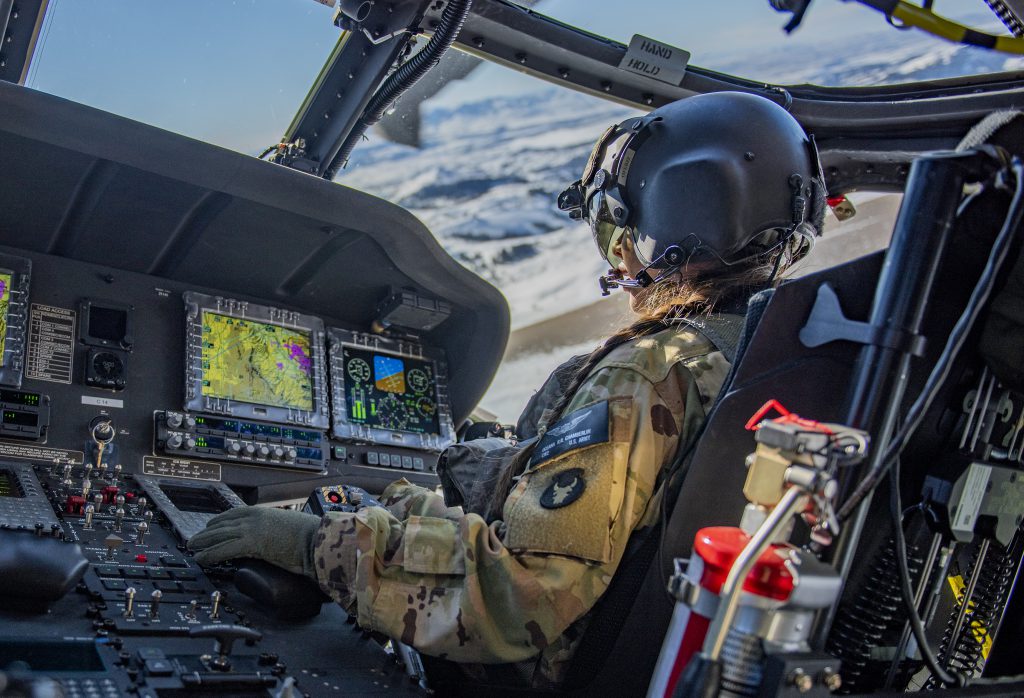
Maj. Robert Taylor/Idaho Military Division Public Affairs
With the arrival of its final two new UH-60M Black Hawks Sunday, the Idaho Army National Guard’s 1-183rd Assault Helicopter Battalion has completely modernize its previous fleet of A/L models to the Army’s most technologically advance multi-role helicopter.
“It’s a reflection of the quality and relevancy of the Idaho Army National Guard,” said Brig. Gen. Farin Schwartz, commander of the Idaho Army National Guard. “Combined with the 116th Cavalry Brigade Combat Team’s modernized armor equipment, the Idaho Army National Guard is one of the most modernized states in the Army National Guard. Modernized equipment enhances our capability to be interoperable with our active duty peers.”
The unit began transitioning to the new model in 2019 and is the fourth airframe unit pilots have flown since 2012. The UH-60M is an upgraded version of the legacy UH-60, designed to execute missions under all weather conditions. Its improvements allow commanders to move Soldiers and equipment faster on the battlespace and to mass effects across the full spectrum of conflict.
“It’s an exciting and unprecedented opportunity to have access to the newest air frame in the U.S. Army’s fleet,” said Lt. Col. Nicole Washington, 1-183rd AHB commander. “It’s exciting being on the leading and cutting edge of aviation. The M model has really set us up as a state and a National Guard entity to continue to lead the way and be on par with active duty counterparts.”
Improvements include a new airframe and propulsion system, more powerful engines and advanced digital avionics inside the cockpit. The glass cockpit is larger to give pilots more situational awareness of what is happening outside the aircraft and four multifunction display screens giving pilots access to multiple systems in real time.
Pilots can track their location on a moving map as well as friendly and enemy positions within the battlespace while communicating securely with other aircraft and ground personnel. Pilots can also map out an air route while in the cockpit to account for a change in mission mid-flight, Washington said.
Chief Warrant Officer 4 John Jacobs, a maintenance test pilot and maintenance test pilot evaluator, said the majority of the helicopter’s upgrades reduce pilot workload and fatigue.
The aircraft physically vibrates less, which Jacobs said makes pilots less tired after flying all day, and features an automated flight director system that functions similarly to a vehicle’s cruise control system. Jacobs said the equipment aids in low visual environments, such as dust and snow conditions, which improves the safety and efficiency of inserting ground forces on the battlefield.
“It’s easier to fly long days,” Jacobs said. “It’s amazing just feeling better when you get out of the cockpit. It’s the difference between driving 500 miles in a 1976 pickup truck versus a 2022 pickup truck.”
Jacobs said the helicopters’ stiffer blades handle sling loads better. The improved blades came in handy when the 1-183rd AHB participated in Idaho’s wildland firefighting efforts last summer. Crews dumped more than 200,000 gallons of water on multiple fires in northern Idaho using the new aircraft.
Pilots began attending a six-week transition course in 2019 to prepare for the new aircraft. The unit received its first UH-60M on Gowen Field in June 2020 and flew the remaining 19 airframes back from New Jersey to Boise over the past 18 months.
The 1-183rd AHB flew the AH-64A Apache for almost 20 years before transitioning to the AH-64D Longbow model in 2012 and then to the UH-60A/L Black Hawk through 2016-2018.
Washington said the multiple transitions caused pilots to go from gauges and dials in the legacy Apache to the technologically advanced Longbows, back to gauges and dials in the UH-60A/Ls before transitioning back to flying digitally. In addition, the transition to Black Hawks required the pilots to integrate crew chiefs into operations, something that wasn’t required in the Apache.
“Now we’ll work to become experts in this airframe, increase our competency and our ability to focus on air assault tasks and combat operations,” Washington said.
Idaho’s ESGR chair volunteers over 20 years
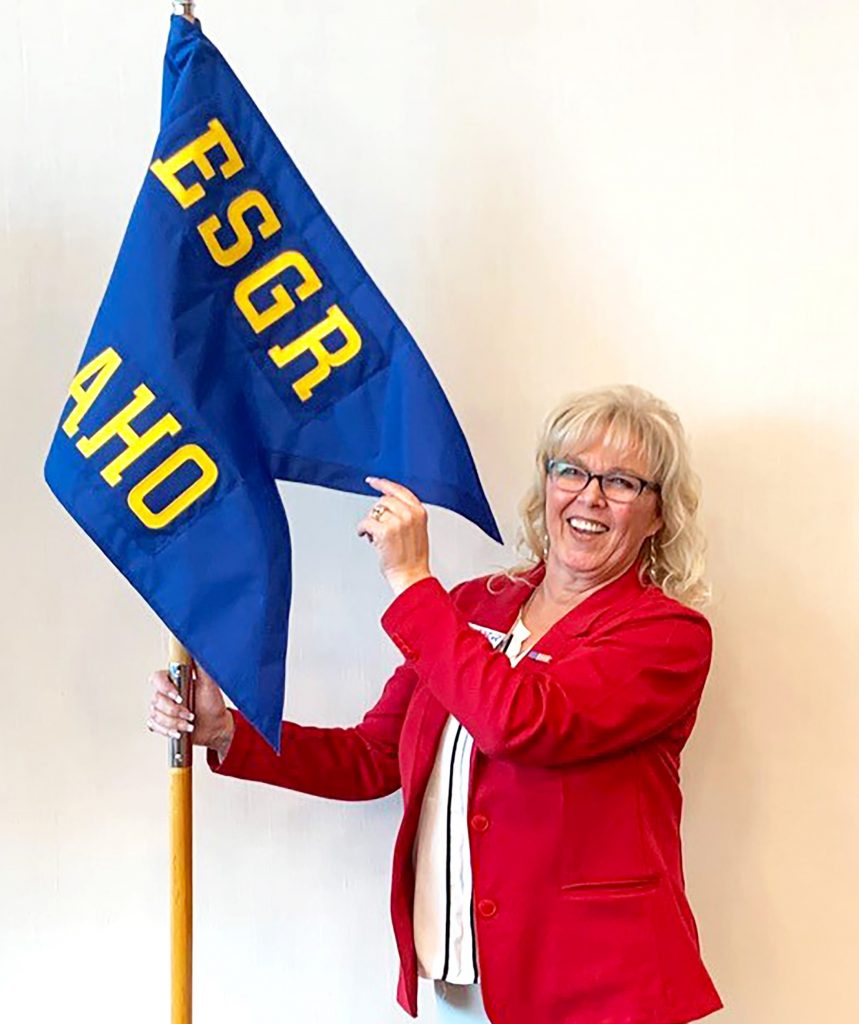
Before Cindy Reese joined the Employer Support of the Guard nearly 21 years ago, she participated in her first-ever employer outreach function, called a Bosslift, where she flew in a C130 to Fort Knox, Kentucky and visited with Soldiers.
She spent several days getting to know the Soldiers while living like one herself exploring tanks, eating in military dining facilities and shooting M16 rifles before returning to Idaho.
“After the other participants and I got off the plane and onto a bus, our event director asked us who had fun and was ready to go home,” said Reese. “Of course we all raised our hands. Then he asked us to take a moment and think of all those who didn’t get to come home from a deployment. There was not a dry eye on the bus. That’s when I decided I wanted to help make a difference and be part of something bigger than myself by joining the ESGR.”
Reese, who also works full time as a service manager for Tadd Jenkins Auto Group in Blackfoot, Idaho has since volunteered with the ESGR, helping to develop the program and relationships between Idaho National Guardsmen and their civilian employers.
She has held various positions including vice chair of the National Volunteer Support Subcommittee, which assists in the management, improvement and execution of ESGR volunteers, information technology and training programs.
Currently, she is serving her fifth year as the ESGR state chair of Idaho and in October, Reese was selected to serve as the National Volunteer Support Subcommittee chair.
For her service with the ESGR, Reese has received numerous awards including the Artillery Order of Molly Pitcher, the Seven Seals Award and the President’s Volunteer Service Award.
“ESGR is very near and dear to my heart,” said Reese. “The things our committee and I have been able to accomplish is because we have a great team, an incredible relationship with the military and we all have a true desire to be part of something more than ourselves. Many of our volunteers, like myself, did not serve in the military and this is our way to give back.”
About ESGR
ESGR is a Department of Defense program established in 1972 that promotes cooperation and understanding between reserve component service members and their civilian employers through outreach, recognition and educational opportunities.
The program operates through a network of more than 3,000 volunteers across 54 committees located in all 50 states, the District of Columbia, Guam, Puerto Rico and the U.S. Virgin Islands. Idaho’s ESGR Committee consists of more than 60 volunteers.
The Idaho National Guard helps to support ESGR and committee goals by promoting local employer outreach events such as Bosslift to build awareness of military missions while also recognizing civilian employers for their contributions and support to mission readiness.
Reese has contributed to more than two dozen state-wide and regional Bosslift events, in addition to other leadership and employer outreach events for organizations across the state, including chamber of commerce briefings.
Additionally, Reese has assisted the committee in recognizing hundreds of civilian employers throughout the state with various awards including the Secretary of Defense Employer Support Freedom Award, the Pro-Patria Award and the Above and Beyond Award.
“The support of our civilian employers is critical,” said Reese. “It’s been a real highlight of my career being able to recognize employers within our communities for that support by presenting them awards to let know how important they are to the success of our Guardsmen.”
In Feb. 2020, Idaho’s Adjutant General Maj. Gen. Michael Garshak, presented Reese and the Idaho ESGR committee, with their own guidon, recognizing the volunteers for their valuable contributions to the Idaho National Guard.
“Receiving the guidon meant a lot to us in the ESGR because it told us how important we are to the Idaho National Guard,” said Reese. “The ESGR would not be as successful as it is, if it were not for continued support of the Idaho Military Division leadership and the ESGR’s dedicated staff.”
“It’s always been about the people”
Reese had the opportunity to meet thousands of Guardsmen over the years, many who she now considers family. Much of the opportunities were life changing and strengthened her passion and commitment for volunteering, she said.
“They are the reason I volunteer,” said Reese. “It’s always been about the people. They are what keeps me going because I get to help make a difference in their lives and their families.”
In 2004, Reese visited Louisiana where thousands of Idaho Army National Guardsmen were conducting premobilization training prior to deploying. She served them Thanksgiving dinner and later shook their hands before they boarded a plane to Iraq.
“As I stood on the tarmac and shook hands with every single one of the thousands of Soldiers leaving, I remember seeing men and women, both young and old, with their backpacks and weapons,” said Reese. “Some had teddy bears and dolls given to them by loved ones. Some had tears in their eyes wondering if it was the last time they would see their families.”
Despite what those Soldiers left behind or sacrificed to deploy, Reese said their level of commitment to serve and do what they signed up for impressed her more than anything she had seen before. It was an once-in-a-lifetime opportunity that changed her, she added.
“The attitude and level of commitment those Soldiers portrayed that day changed the way I felt about the things I did in my own life,” said Reese. “It made me want to be more committed, dedicated and stand taller for the things I knew were right.”
In July 2019, Reese volunteered as chair of a committee that helped bring a replica of Washington D.C.’s Vietnam Veterans Memorial Wall to Blackfoot, Idaho. After the project completed two years later, “The Wall That Heals” opened for viewing during a ceremony in September 2021, where thousands of visitors attended.
 Official Government Website
Official Government Website